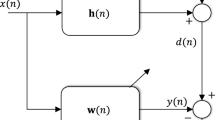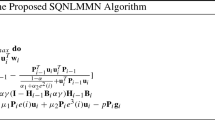Abstract
The feature least-mean-square (F-LMS) algorithm has already been introduced to exploit hidden sparsity in lowpass and highpass systems. In this paper, by proposing the extended F-LMS (EF-LMS) algorithm, we boosted the F-LMS algorithm to exploit hidden sparsity in more general systems, those which are neither lowpass nor highpass. To this end, by means of the so-called feature matrix, we reveal the hidden sparsity in coefficients and utilize the \(l_1\)-norm to exploit the exposed sparsity. As a result, the EF-LMS algorithm will improve the convergence rate and the steady-state mean-squared error (MSE) as compared to the traditional least-mean-square algorithm. Moreover, in this work, we analyze the convergence behavior of the coefficient vector and the steady-state MSE performance of the EF-LMS algorithm. Through synthetic and real-world experiments, it has been seen that the EF-LMS algorithm can improve the convergence rate and the steady-state MSE whenever the hidden sparsity is revealed.











Similar content being viewed by others
Notes
This function was inspired by the discard function proposed in [36].
References
M.S. Aslam, M.A.Z. Raja, A new adaptive strategy to improve online secondary path modeling in active noise control systems using fractional signal processing approach. Signal Process. 107, 433–443 (2015)
J. Benesty, S.L. Gay, An improved PNLMS algorithm, in Proceedings IEEE International Conference on Acoustics, Speech and Signal Processing (ICASSP), May, Dallas, USA (2002), pp. 1881–1884
Z.A. Bhotto, A. Antoniou, A family of shrinkage adaptive-filtering algorithms. IEEE Trans. Signal Process. 61, 1689–1697 (2013)
N.I. Chaudhary, S. Zubair, M.S. Aslam et al., Design of momentum fractional LMS for Hammerstein nonlinear system identification with application to electrically stimulated muscle model. Eur. Phys. J. Plus 134, 407 (2019)
N.I. Chaudhary, S. Zubair, M.A.Z. Raja et al., Normalized fractional adaptive methods for nonlinear control autoregressive systems. Appl. Math. Model. 66, 457–471 (2019)
G.S. Chaves, M.V.S. Lima, H. Yazdanpanah, P.S.R. Diniz, T.N. Ferreira, A simple sparsity-aware feature LMS algorithm, in Proceedings 27th European Signal Processing Conference (EUSIPCO) (A Coruna, Spain, Sept., 2019), pp. 1–5
Y. Chen, Y. Gu, A.O. Hero, Sparse LMS for system identification, in Proceedings IEEE International Conference on Acoustics, Speech and Signal Processing (ICASSP) (Taipei, Taiwan, Apr., 2009), pp. 3125–3128
P.S.R. Diniz, Adaptive Filtering: Algorithms and Practical Implementation, 4th edn. (Springer, New York, 2013)
P.S.R. Diniz, H. Yazdanpanah, M.V.S. Lima, Feature LMS algorithms, in Proceedings IEEE International Conference on Acoustics, Speech and Signal Processing (ICASSP), April, Calgary, Alberta, Canada (2018), pp. 4144–4148
P.S.R. Diniz, H. Yazdanpanah, M.V.S. Lima, Feature LMS algorithm for bandpass system models, in Proceedings 27th European Signal Processing Conference (EUSIPCO) (A Coruna, Spain, Sept., 2019), pp. 1–5
B. Farhang-Boroujeny, Fast LMS/Newton algorithms based on autoregressive modeling and their application to acoustic echo cancellation. IEEE Trans. Signal Process. 45, 1987–2000 (1997)
Y. Gu, J. Jin, S. Mei, \(l_0\) norm constraint LMS algorithm for sparse system identification. IEEE Signal Process. Lett. 16, 774–777 (2009)
S. Haykin, Adaptive Filter Theory, 4th edn. (Prentice Hall, Englewood Cliffs, NJ, 2002)
S. He, Y. Lin, Cauchy distribution function-penalized LMS for sparse system identification. Circuits Syst. Signal Process. 38, 470–480 (2019)
J. Huang, R. Diamant, Channel impulse responses from Mar. 2019 long range experiment (Mediterranean Sea), IEEE Dataport (2019). https://doi.org/10.21227/nzgr-ds72.
K. Jiang, H. Zhang, H.R. Karimi, J. Lin, L. Song, Simultaneous input and state estimation for integrated motor-transmission systems in a controller area network environment via an adaptive unscented Kalman filter, IEEE Trans. Syst. Man Cybern Syst. (2018). https://doi.org/10.1109/TSMC.2018.2795340
Y. Li, C. Zhang, S. Wang, Low-complexity non-uniform penalized affine projection algorithm for sparse system identification. Circuits Syst. Signal Process. 35, 1611–1624 (2016)
M.V.S. Lima, T.N. Ferreira, W.A. Martins, P.S.R. Diniz, Sparsity-aware data-selective adaptive filters. IEEE Trans. Signal Process. 62, 4557–4572 (2014)
A. Mandal, R. Mishra, Digital equalization for cancellation of noise-like interferences in adaptive spatial filtering. Circuits Syst. Signal Process. 36, 675–702 (2017)
A. Mehmood, N.I. Chaudhary, A. Zameer et al., Novel computing paradigms for parameter estimation in Hammerstein controlled auto regressive auto regressive moving average systems. Appl. Soft Comput. 80, 263–284 (2019)
A. Mehmood, A. Zameer, N.I. Chaudhary et al., Backtracking search heuristics for identification of electrical muscle stimulation models using Hammerstein structure. Appl. Soft Comput. 84, 105705 (2019)
R. Meng, R.C. de Lamare, V.H. Nascimento, Sparsity-aware affine projection adaptive algorithms for system identification, in Proceedings Sensor Signal Processing for Defence (SSPD) (London, UK, Sept., 2011), pp. 1–5
L. Murali, D. Chitra, T. Manigandan, B. Sharanya, An efficient adaptive filter architecture for improving the seizure detection in EEG signal. Circuits Syst Signal Process 35, 2914–2931 (2016)
T. Padhi, M. Chandra, A. Kar, M.N.S. Swamy, A new hybrid active noise control system with convex combination of time and frequency domain filtered-x LMS algorithms. Circuits Syst. Signal Process. 37, 3275–3294 (2018)
K. Pu, J. Zhang, L. Min, A signal decorrelation PNLMS algorithm for double-talk acoustic echo cancellation. Circuits Syst. Signal Process. 35, 669–684 (2016)
M.A.Z. Raja, R. Akhtar, N.I. Chaudhary et al., A new computing paradigm for the optimization of parameters in adaptive beamforming using fractional processing. Eur. Phys. J. Plus 134, 275 (2019)
G. Reina, A. Vargas, K. Nagatani, K. Yoshida, Adaptive Kalman filtering for GPS-based mobile robot localization, in Proceedings IEEE International Workshop on Safety, Security and Rescue Robotics (Rome, Italy, Sept., 2007), pp. 1–6
A.H. Sayed, Adaptive Filters (Wiley-IEEE, New York, USA, 2008)
K. Shi, P. Shi, Adaptive sparse Volterra system identification with \(l_0\)-norm penalty. Signal Process. 91, 2432–2436 (2011)
A. Tarighat, A.H. Sayed, Least mean-phase adaptive filters with application to communications systems. IEEE Signal Process. Lett. 11, 220–223 (2004)
S. Werner, J.A. Apolinário Jr., P.S.R. Diniz, Set-membership proportionate affine projection algorithms. EURASIP J. Audio Speech Music Process (2007). https://doi.org/10.1155/2007/34242
B. Widrow, M.E. Hoff, Adaptive switching circuits. IRE WESCOM Conv. Rec. 4, 96–104 (1960)
H. Yazdanpanah, J.A. Apolinário Jr., P.S.R. Diniz, M.V.S. Lima, \(l_0\)-norm feature LMS algorithms, in Proceeding 2018 IEEE Global Conference on Signal and Information Processing (GlobalSIP), Nov., Anaheim, CA, USA, (2018), pp. 311–315
H. Yazdanpanah, P.S.R. Diniz, New trinion and quaternion set-membership affine projection algorithms. IEEE Trans. Circuits Syst. II Express Briefs 64, 216–220 (2017)
H. Yazdanpanah, P.S.R. Diniz, Recursive Least-Squares algorithms for sparse system modeling, in Proceedings IEEE International Conference on Acoustics, Speech and Signal Processing (ICASSP) (New Orleans, LA, USA, Mar., 2017), pp. 3879–3883
H. Yazdanpanah, P.S.R. Diniz, M.V.S. Lima, A simple set-membership affine projection algorithm for sparse system modeling, in Proceedings 24th European Signal Processing Conference (EUSIPCO) (Budapest, Hungary, Aug., 2016), pp. 1798–1802
Y. Yu, H. Zhao, B. Chen, Sparseness-controlled proportionate affine projection sign algorithms for acoustic echo cancellation. Circuits Syst. Signal Process. 34, 3933–3948 (2015)
H. Zhang, J. Wang, Active steering actuator fault detection for an automatically-steered electric ground vehicle. IEEE Trans. Veh. Technol. 66, 3685–3702 (2017)
Acknowledgements
The authors would like to thank the São Paulo Research Foundation (FAPESP) Grants #2015/22308-2, #2019/06280-1 and the Coordenação de Aperfeiçoamento de Pessoal de Nível Superior – Brasil (CAPES) – Finance Codes 23038.018065/2018-17 and 88881.371305/2019-01.
Author information
Authors and Affiliations
Corresponding author
Additional information
Publisher's Note
Springer Nature remains neutral with regard to jurisdictional claims in published maps and institutional affiliations.
Rights and permissions
About this article
Cite this article
Yazdanpanah, H., Apolinário, J.A. The Extended Feature LMS Algorithm: Exploiting Hidden Sparsity for Systems with Unknown Spectrum. Circuits Syst Signal Process 40, 174–192 (2021). https://doi.org/10.1007/s00034-020-01461-3
Received:
Revised:
Accepted:
Published:
Issue Date:
DOI: https://doi.org/10.1007/s00034-020-01461-3




